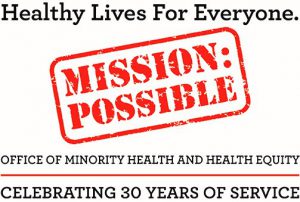Mission Possible: Preparing and Responding to Disasters through a Health Equity Lens
Posted on byIt was September 2017, and like many others, I was watching as Hurricane Maria moved across the Atlantic Ocean heading towards the US Virgin Islands and Puerto Rico. Having been part of the recent responses to Hurricanes Harvey and Irma, I was all too aware of the potential for devastation, especially for the most vulnerable among us. Previous disasters have shown that certain groups of people face greater risk during and after disasters. This includes those who may have difficulty accessing or receiving standard resources before, during, or after an emergency.

People are not equally able to access resources and opportunities, nor are they equally exposed to hazards. For example, low-income and predominantly minority communities have fewer resources, higher vulnerabilities to disease, and less access to healthcare. Many of these communities are in areas prone to natural disasters and other threats, such as the Gulf Coast. These communities are less able to cope with natural hazards due to continuous stressors and gaps in community resilience.[i] During a disaster, these gaps are exacerbated, necessitating preparedness policies and practices that account for social, economic, and health disparities.
To understand how public health agencies are addressing the needs of vulnerable populations in emergencies while working to reduce social, economic, and health disparities, I moderated a panel at the annual workshop of the Natural Hazards Center titled Root Causes: Social Inequality and Vulnerability in Disasters.
During the panel, we discussed the following barriers to addressing disparities and vulnerability in disasters:
- Government mistrust. Mistrust of government and institutions is a deep-seated barrier that has historic roots and can be difficult to change. Diverse communities often do not feel respected and may not have the political power to garner necessary resource.
- Layered disasters. Hazards tend to harm segments of the population that were already disadvantaged before a disaster. There is differential vulnerability for people by where they live, work, and play.
- Organizational resilience. The organizations that address the day-to-day needs of vulnerable populations are themselves vulnerable during a disaster due to resource constraints. These organizations may exhaust their yearly budget on a disaster response and may not be able to continue to provide day-to-day needs of the populations they serve.
- Misconceptions. In the past, people with disabilities and other impairments may have been perceived as unable to care for themselves, unable to function in daily activities, and unable to make decisions about their health and welfare. Because of these and other misconceptions, segments of the populations are marginalized, causing systematic exclusion from the social environment.
The panel also offered examples of ways to address these barriers, such as the following:
- Collaboration. One panelist described how her city uses emergency managers as a conduit to other social services. During a disaster response, they have social services and emergency management in the same room, increasing collaboration and providing both immediate assistance and the potential for long-term improvement to individual’s day-to-day life.
- Engagement. One panelist discussed how they purposefully ensure Community Emergency Response Teams (CERT) mirror their community. To ensure broader engagement by the community, the CERT training courses are inclusive and accessible. For example, trainings are in a building that is centrally located and accessible to persons with disabilities, sign language interpreters and translators are available, and training times are varied to accommodate those who work or have young children.
- Inclusion. One panelist detailed how they are sure to include appropriate representatives from vulnerable populations in their planning meetings. Inclusion of vulnerable populations in emergency planning allows the other planners to recognize their strengths and hear directly from them about their needs.
- Representation. Research has shown that racial and ethnic minorities often experience disproportionate negative impacts from disasters. Thus, inclusion of minorities in disaster mitigation is important. Panelists discussed participation in programs such as the Bill Anderson Fund, which supports individuals from underrepresented groups as they complete graduate programs related to hazards, disaster, and emergency management.[ii]
Although addressing the specific needs of vulnerable populations in disasters has received more emphasis in recent years, many of the social, economic and health disparities at the root of vulnerability during disasters persist. Addressing the needs of vulnerable populations in emergencies includes improving day-to-day life and harnessing the strengths of these groups. Many public health practitioners have recognized that a health equity lens and consideration of social determinants of health (e.g., healthcare access, education, built environment) is required when addressing disease management.[iii] A health equity lens should also be applied to emergency preparedness, response, and recovery activities to address disparities to ensure that disparities are not inadvertently created or exacerbated during disasters.
How are you working in your community to apply a health equity lens to emergency preparedness, response, and recovery activities?
Special thanks to Dr. Wolkin for contributing this blog in recognition of National Preparedness Month and as part of the celebration of the 30th anniversary commemoration of CDC’s Office of Minority Health and Health Equity. Our theme for the 30th anniversary commemoration is Mission: Possible. We believe “healthy lives for everyone” is possible and a goal that resonates in public health.
[i] https://www.domesticpreparedness.com/healthcare/building-community-resilience-through-health-equity/
[ii] http://billandersonfund.org/programs/mentor-program/
[iii] https://www.cdc.gov/socialdeterminants/tools/index.htm
Posted on by


